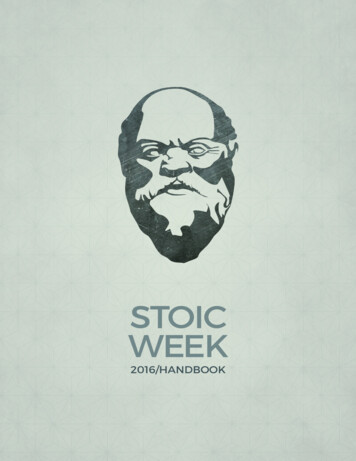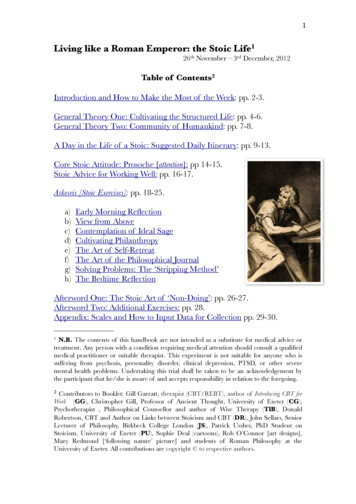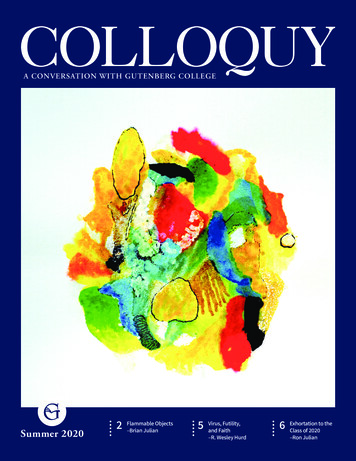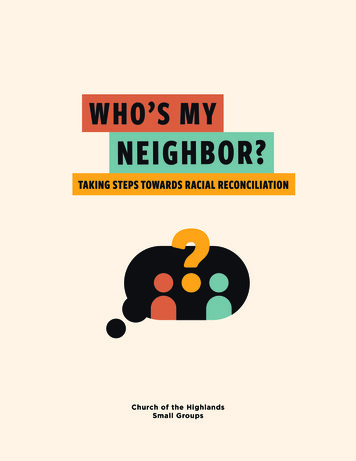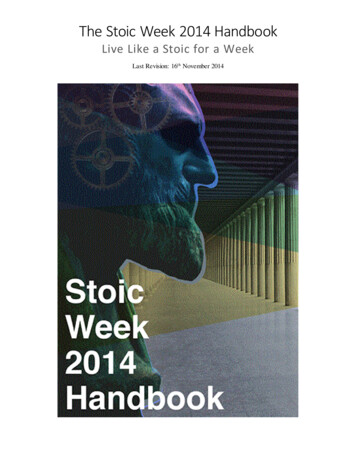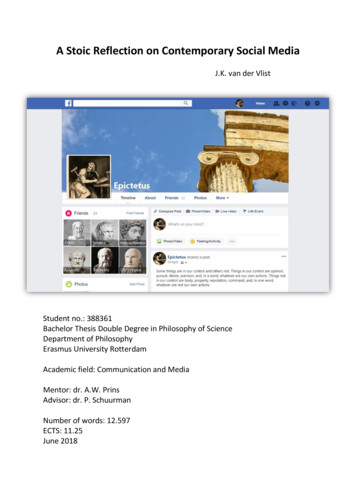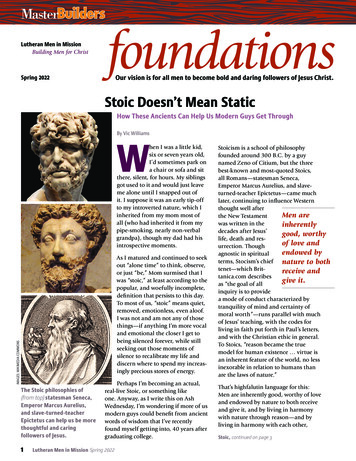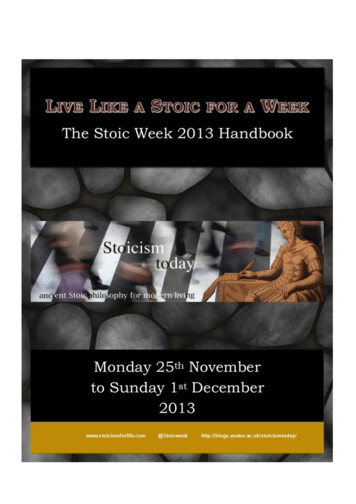
Transcription
Stoic Week Handbook1Live Like a Stoic for a WeekMonday 25th November 2013–Sunday 1st December 2013The Stoic Week 2013HandbookDownload questionnaires and recordings, etc., from the Stoicism Today -week-2013/Stoicism for Everyday Life public event, 30 November 2013:www.stoicismforlife.comThe contents of this handbook are not intended as a substitute for medical advice or treatment. Any person with a condition requiringmedical attention should consult a qualified medical practitioner or suitable therapist. This experiment is not suitable for anyone who issuffering from psychosis, personality disorder, clinical depression, PTSD, or other severe mental health problems. Undertaking this trialshall be taken to be an acknowledgement by the participant that they are aware of and accept responsibility in relation to the foregoing.
Stoic Week Handbook2ContentsIntroduction . 3Who Were the Stoics?. 5Central Stoic Ideas . 61. Value . 62. Emotions . 63. Nature & the Community of Humankind . 7Daily Stoic Meditations for Stoic Week . 9Early-Morning Meditation . 9During the Day: Stoic Mindfulness . 9Late-Evening Meditation .10Instructions on how to use the Stoic self-monitoring record .11Stoic Week Day-by-Day .15Monday: What is in our Power? .16Tuesday: Self-Discipline & Stoic Simplicity .18Wednesday: Action & the Stoic Reserve Clause .20Thursday: Stoic Mindfulness .22Friday: Emotions & Preparation for Adversity .25Saturday: Philanthropy .27Sunday: The View from Above .30After Stoic Week .32Appendices .33Meet the Team .33Further Reading .34Six Modern Books on Stoicism for Beginners .36Information on the Scales .37
Stoic Week Handbook3IntroductionWelcome to this opportunity to take part in a unique experiment: to follow the two millennia old Stoic Philosophy as a Wayof Life in the modern day! This handbook stems from a project bringing together academics and psychotherapists who wantto explore the potential benefits of ancient Stoicism. In November 2012 we ran the initial Stoic week pilot study to see ifthe idea was feasible. It proved to be more popular than we could have anticipated. This year we are repeating theexperiment in the light of the feedback we gained from the pilot study.In this handbook, you will find guidance on how to adapt and follow Stoic principles, with a combination of general theoryand more specific, step-by-step guidance on certain Stoic exercises. These materials have been prepared by experts in thefield and give you an unusual, and free, chance for personal development.Q: How do I know that living like a Stoic will benefit me?A: You don’t. Indeed, one of the reasons we are conducting the experiment is to find out whether, and how, Stoic practicescan help us to live better lives. We found that most of the people who took part in the pilot study last year found theexercise a very positive one. On a number of well-validated and widely used wellbeing scales, there was a 10% inwellbeing. The benefit for you may be educational - in understanding what Stoicism is about - it may be psychological helping you become more resilient and possibly even happier - it may be moral - you may find that the week helps youdevelop certain desirable ethical qualities. Or you may find that Stoicism as a philosophy just isn’t for you, which might initself be a valuable thing to learn.Q: What's the basic idea?A: This is what you need to do:1. Complete the questionnaires at the beginning and end of Stoic Week (see below).2. Follow the daily schedule, consisting of a text for reflection and Stoic meditation morning and evening. Atlunchtime, or at another time that is good for you, consider the Stoic exercise for that day.The morning and evening meditation practices will provide you with a daily routine or structure to help you reflect onwhat happens each day. You'll begin by learning to keep a record of your thoughts, actions, and feelings, and to startobserving them in a more detached and "philosophical" way. One of the main practical themes that runs through Stoicism,and therefore this Handbook, is the strategy of distinguishing between things under your control and things not. TheStoics believed this takes training to do well but that it's the key to self-discipline and overcoming emotional disturbance.This requires continual attention to your own thoughts and judgements, so we can describe it as a kind of "mindfulness"practice. We'll then build upon this foundation by exploring different Stoic concepts and techniques each day, throughthe course of the week.Q: I’m worried I may not have time to do everything. How can I give myself the best chance of makingthe most of it?A: It will probably be helpful for you to think of this as a definite, short-term commitment - similar perhaps to the effortyou would put in to rehearsing the week before appearing in a play, or an exam, or training for a sporting event. Ideally,this might take about 15 minutes in the morning and evening, and the same at lunchtime, although you might want tospend more or less.
Stoic Week Handbook4Q. How could I use of modern technology whilst living like a Stoic?Here are some ideas: Record a video diary of your experiences of living like a Stoic - then, if you want, post it to YouTube or the StoicismToday blog. Blog about your experiences. Record your experiences on Facebook.Tweet about your experiences, or tweet Stoic adages as you go along (#stoicweek).Each day summarise what you have learnt as a tweet.Use your phone to set reminders to start your Stoic practices.Which of these appeal to you? How many other ways can you use technology to help you live like a Stoic? If you are doingthe experiment with other people, it might help to discuss your experiences each day. Perhaps you could have a 10 minuteStoic coffee each day where you touch base with others and discuss how you are doing. If you are not geographically closeto other participants, you might use the Stoicism Today blog to connect with others, and indeed there will be opportunitiesto post on the blog daily about how the week is going and to post any general reflections, or quotations from Stoicismwhich you particularly find useful.If you want to have your video diaries or blog entries about Stoic Week featured on the Stoicism Today blog, contactPatrick Ussher.Q: How will I know whether it has helped or not?A: You will fill in questionnaires before and after the week which will help you to see objective measures of change andalso allow you to reflect on the experience. Your doing so will also help us to evaluate the benefits and limitations of Stoicpractices. In Stoic terms, you could say participation in the experiment can be seen as part of living a good life.Q: How do I register for Stoic Week?To register for Stoic Week, please fill out the pre-week questionnaires on the weekend, or on Monday if you miss doingit on the weekend, before Stoic Week. All questionnaires and other downloads are available from the Stoic Week 2013page on the Stoicism Today -week-2013/You can find further information about the questionnaires in the relevant appendix.
Stoic Week Handbook5Who Were the Stoics?Although you don’t need to know much about the ancient Stoics themselves in order to take part in Stoic Week, it might be helpfulto say just a little bit about who the Stoics were.The Stoic school of philosophy was founded in Athens around 300 BC by Zeno, who was originally from Cyprus. After studying formany years in different schools of Athenian philosophy he eventually set up on his own, meeting with others at the Painted Stoa onthe northern edge of the Athenian marketplace, hence the name. Zeno was reputedly very highly regarded by the Athenians for hisexceptional self-discipline and reputation as a teacher, and as a role-model to youths. After his death his student Cleanthes took overas the head of the school. He was succeeded in turn by Chrysippus, regarded as one of the greatest intellectuals of the ancient world,who is said to have written over 700 books. Sadly all of these are lost apart from quotations in later authors and a few papyrusfragments recovered from a famous library of philosophical texts at Herculaneum.The Stoa continued as a school in Athens probably right down to the first century BC, during which at some point Athens lost itsstatus as the preeminent centre of philosophy in the ancient world. From the first century BC onwards Rome became the dominantforce in political and intellectual life and we know of a number of important Stoics from the first and second century AD. The mostfamous of these are Seneca, Epictetus, and the emperor Marcus Aurelius. For our purposes these three Roman Stoics have two greatadvantages over their Athenian predecessors: first, their focus was very much on how one might use Stoicism as a guide to living well,and second, large parts of their writing survived and we can read them today.The Roman statesman Seneca, who was originally from Spain, suffered at the hands of a number of emperors, and was banished fora time to the island of Corsica. He later became tutor to the Emperor Nero, who degenerated into a tyrant and finally ordered hisexecution by forced suicide. Many of his Letters and Essays address the challenge of coping with extreme situations.Epictetus was a slave originally from Asia Minor whose Roman master eventually freed him. He went on to set up his ownphilosophical school in Nicopolis on the western coast of Greece, and became a highly-regarded Stoic teacher. He wrote nothing, buthis pupil Arrian took notes of his conversations and turned them into the Discourses, which he then summarized in the shorter Handbook(Enchiridion).Marcus Aurelius was Roman Emperor from 161 to 180 AD. Much of his reign was spent on the borders of the empire, fighting theGermans, who had invaded Italy. His work, the Meditations, seems to be a philosophical notebook or diary, some of which wascomposed during his time on campaign. This is his attempt to reflect on the various difficulties and pressures that come with the jobof ruling the known Western world. He refers to the teachings of Epictetus, although neither he nor Epictetus appear to make anymention of their predecessor Seneca.Much of the material in this handbook is drawn from the works of these three Roman Stoics, particularly Epictetus whose shortHandbook offers clear advice to someone who wants to live a Stoic life. In a sense, the handbook you're currently reading is intendedas a modern version of the ancient Handbook of Epictetus, although we strongly encourage you to read the original as well as otherclassical texts, and modern commentaries, to deepen your understanding of Stoic philosophy and practices.
Stoic Week Handbook6Central Stoic IdeasWhat is Stoicism? How might it help us to live better, happier lives today? Some of you will be drawn to this experiment because youalready know a little bit about Stoicism and want to put it into practice for themselves. Others may know very little about Stoicismand are simply curious to learn more. The ancient philosophical system of Stoicism was traditionally known for being both large andcomplex, addressing a wide range of topics. So it will be impossible to introduce it all, but here are three central ideas that are at theheart of Stoic philosophy.1. ValueThe Stoics argued that the most important thing in life and the only thing with real value is ‘virtue’ or ‘excellence of character’. Thisincludes the traditional virtues like moderation, courage, justice, and wisdom but should also be understood more broadly as anexcellent mental state. They identify this with rationality. It is this excellent, rational, virtuous character that enables human beingsto act as best as they can in any given circumstance.The central Stoic claim is that this excellent mental state is ultimately the only thing that really matters; it is the only thing that isreally good and it is the only thing that can bring us wellbeing or happiness. Without this we shall never be happy. Cultivating thisexcellent character ought to be our top priority, above all other things, if we want to live a good, happy life.Conversely all those external things that people often pursue for the sake of happiness – a good job, money, success, fame, and so on– cannot guarantee us happiness, the Stoics claim. They could well be parts of a happy life but, on their own, they will never deliver– not without an excellent, rational frame of mind.However this stress on the role of virtue does not mean that those things that people normally think of as good are not important –things such as health, having good friends, and financial means. It is just that whether you have any of these other things or not doesnot make any difference ultimately to your ability to live a good life.So the Stoics suggest that if we are serious about leading a good, happy, contented life we ought to focus our attention inwards, notoutwards, at least until we have started to make progress towards developing an excellent character. But this doesn’t mean theysuggest we turn our backs on the outside world. On the contrary, the reason for developing a virtuous character is that it enables usto interact with the world in a better, kinder, and more positive way.The best way to approach life, the Stoics suggest, is to think of oneself as an archer who does his or her best to fire the arrow wellbut accepts that once it has flown it may be blown off course and miss the target. In this analogy, our intentions are like preparing tofire the arrow, but the outcome of our actions, like hitting the target, is beyond our control and partly the result of external events.Although the Stoics are not against pursuing external things or preferring one external thing over another (it is better to be healthythan sick, better to be rich than poor), they do warn that if we get too carried away in the pursuit of such things we run the risk ofcompromising the one thing that is most important – our excellent, rational character. As soon as we start to get stressed, annoyed,impatient, frustrated, or angry about any of the external things that we are pursuing in our daily lives, then we run the risk ofcompromising the one thing that really can enable us to live a good life for the sake of something that ultimately cannot. That’s theline the Stoics say we ought not to cross.2. EmotionsIn the popular imagination a Stoic is someone who denies or represses their emotions in a potentially unhealthy way. This is largelyjust a widespread misconception, though. The real Stoic position is different from this in a number of ways. The central claim theStoics make is that our emotions are ultimately the product of judgements we make. If we feel fear it is because we have judged that
Stoic Week Handbook7something terrible might be about to happen to us. If we feel anger it is because we have judged that something bad is happening tous right now.The Stoics do not suggest that we should repress or deny these – instead they want to show us how we can uproot these sorts ofunpleasant emotions altogether. This is something we can do, the Stoics say, because these emotions are the product of ourjudgements about what is good and bad in life. Change the judgements and you will change the emotions. Our emotions are typicallywithin our control, even if it might not feel like it some of the time.However, the Stoics also acknowledge the existence of certain reflex-like aspects of emotion, physiological reactions, such asblushing, stammering, or being startled. These typically remain involuntary and beyond our direct control, although we can choosehow we respond to them and whether we allow ourselves to dwell on or escalate our first impressions and initial reactions. Crucially,in the same way that faulty judgements lead to irrational emotions or unhealthy desires, so too will wise judgements lead to healthydesires and emotions. For example, the Stoics claimed there were three broad categories of good desires and emotions, which areboth rational to possess and naturally follow as a consequence of developing virtuous attitudes:1. Joy or delight, in the experience of what is truly good, as opposed to empty or unhealthy pleasures.2. Caution or discretion, toward the prospect of what is truly bad, as opposed to irrational fear or cowardice.3. Wishing or willing what is truly good, including the wellbeing of others, as opposed to excessively craving health, wealthor reputation.So the Stoic Sage is not a cold fish. In fact, the ancient Stoics repeatedly said their goal was not to be as unfeeling as someone with aheart of stone or iron but to develop the natural affection we have for those close to us, in accord with wisdom and virtue,ultimately extending it to all of mankind. Marcus Aurelius therefore praised his own Stoic tutor, Sextus of Chaeronea, for beingfull of love, or natural affection, and yet free from unhealthy passions (Meditations, 1.9). Later, Marcus asks when he will achievesuch an affectionate and contented state of being himself (Meditations, 10.1).Now, let’s connect this with what the Stoics say about value. Take a trivial example like being late for a meeting or appointment. Ifwe are running late due to bad traffic or public transport delays or whatever and we start to get annoyed it is because we are at somelevel judging that something bad is happening, that it really matters that we get to the appointment on time, that something bad willhappen if we get there late, and so on. But of course none of these things really matter for they are all external to us. It is always goodto be on time and we would prefer not to be late, but whether we are on time or late won’t really affect our well-being, in the sensethat it doesn't make us ethically bad people. By contrast getting annoyed will directly affect our well-being because it will undermineand damage the only thing that can guarantee it – a good state of character.3. Nature & the Community of HumankindSorting out our judgements about the world brings us to the nature of the world itself. One of the most famous ancient Stoic slogansis that we ought to live in harmony with Nature. What did they mean by this? Well, the Stoics thought of Nature in two key ways.The first is as a single, organic whole in which everything is interconnected. The cosmos is like a single living being. Like all otherliving beings it is in a continual process of change. So, when facing the world we ought to see ourselves as part of it. We are but onesmall component or element within a much larger entity. We are not the centre of the world and it is not all about us. The largerprocess of change, growth, and decay that take place in Nature are inevitable and ultimately out of our control. There is nothing tobe gained from trying to resist these larger processes and resisting them produces frustration, anger, and disappointment. Instead,we ought to embrace Nature on its own terms and accept our place within it as limited, finite beings, with limited power and alimited lifespan – but also as parts of something much greater than us.
Stoic Week Handbook8Nature is not just something 'outside us' however, but is something 'within us'. All living beings are ‘parts’ of nature and reflect herlaws. The Stoics believe that nature has made most animal species, and especially the human species, to be social in character. Weform attachments, we live in community, and we wish to find a partner and raise children. The ‘self’ in Stoic thought is intrinsicallya ‘social self’. From this natural affection stems the Stoic ideal of the ‘community of humankind’. As Marcus Aurelius writes (2.1)‘We were born for cooperation, like feet, like hands, like eyelids, like the rows of upper and lower teeth. So to work in oppositionto one another is against nature: and anger or rejection is opposition,’ and Epictetus also writes that we should consider ourselves tobe ‘citizens of the world’ (1.9). So we, in a sense, fulfil our own natures when we act kindly or benevolently, whether or not theyare following their natural social instincts.***If you are going to follow Stoic Week then you need to be open to these three central ideas. You don’t need to accept them uncriticallybut you do at least need to be prepared to explore them further and consider whether they seem to you actually true as well aspotentially beneficial to you in how you lead your life. The Stoics claimed that they do offer some therapeutic benefit, preciselybecause they are true!Nevertheless, our aim in this project is not to try to convince you of the truth of these claims but simply to see if they are helpful foryou in how you lead your life. If these three central ideas seem completely absurd to you then it may be that Stoic Week is not theright experiment for you.
Stoic Week Handbook9Daily Stoic Meditations for Stoic WeekOver the course of Stoic Week, we'd like you to commit yourself to employing certain Stoic practices everyday. These are the morning and evening meditations, which will form the basis of your Stoic practice thisweek, giving you a structured morning and evening routine. This combination of a structured morning andevening routine and Stoic mindfulness will give you a good starting point and daily framework. Let's nowexplore the morning and evening meditations in more detail.Early-Morning MeditationWhen you wake up each morning, take a few moments to compose yourself and then patiently rehearse the day ahead,planning how you can make yourself a better person, while also accepting that some things lie beyond your control.1.Marcus Aurelius talks about walking on one's own to a quiet place at daybreak and meditating upon the stars andthe rising Sun, preparing for the day ahead. You can also do this at home, sitting on the end of your bed, or standingin front of the mirror in your bathroom, and still think of the sun rising against a backdrop of stars.2.Pick a specific philosophical principle that you want to rehearse and repeat it to yourself a few times before imagininghow you could put it into practice during the rest of the day. You might choose the key general Stoic theme: “Somethings are under our control whereas others are not”, and to think about giving more importance to being a goodperson and acting well and treating things you cannot control as ultimately much less important.3.Alternatively, you might pick a specific virtue that you want to cultivate and prepare yourself mentally for your dayahead, in broad outline, imagining how you would act if you showed more wisdom, justice, courage, or moderation.4.Practise this meditation for about 5-10 minutes, picking out key events or specific challenges that might arise.Once you’ve got into the habit of doing this, try imagining greater challenges in the day ahead such as some of your plansnot going as you hope and dealing with difficult people. As you consider a possible difficulty, think about how you couldtackle it with a Stoic principle or virtue.You can download a free video and audio exercise on the Stoic Early Morning Meditation from the main Stoic Week 2013page c-week-2013/During the Day: Stoic MindfulnessNowadays, we understand 'mindfulness' to be about paying attention to one's present moment experience with kindnessand non-judgementally. The Stoics also had a technique, called prosoche, which involved paying attention to the presentmoment.‘Stoic mindfulness’, however, is not just about paying attention to the moment. Neither is it about focussing on yourbreath, or things you are doing at the level of sensation, as it is in Buddhist mindfulness. That is not to say that such Buddhistmindfulness techniques would not complement a Stoic’s actions. Indeed, they would: focussing on the moment, and doingwhat you do with care, is a key Stoic quality. But ‘Stoic mindfulness’ is also a gentle yet consistent monitoring of yourselfthroughout the day, which asks: ‘am I concerned here with something which is in my control or not in my control?’
Stoic Week Handbook10Epictetus gives us the example of a singer with stage-fright. This person has ‘placed himself’ in something he cannotcontrol, which is what the crowd thinks of him, such that his happiness depends on that. Epictetus says:‘When I see man in anxiety, I say to myself, “what can it be that this fellow wants? For if he did not want something that was outsideof his control, how could he still remain in anxiety? That is why when singing on his own he shows no anxiety, but does so what heenters the theatre, even though he has a beautiful voice. For he does not wish merely to sing well, but also to win applause, and that is nolonger under his control.Why is this? Why, he simply does not know what a crowd is, or the applause of a crowd.hence he mustneeds tremble and turn pale.’2.13.This is because the singer did not ask himself: ‘Where, in this situation, should I ‘place myself’?’ Had he asked this, hewould have decided to focus purely on the performance of his art. Of course, the Stoic singer will be glad if the crowdapplauds, but applause was never the point of his singing. The irony, of course, is that the one who focusses on theperformance of his art, on being ‘in the zone’, is more likely to do his or her task well, and to win the applause of thecrowd anyway. In any event, the key practice is to ask yourself: ‘where I am placing myself here?’ and if, as Epictetus toldhis students, you find your thoughts are concerned with things you cannot control, remember to say to yourself: ‘that isnothing to do with me!’ [Encheiridion, §1].Late-Evening MeditationEpictetus and Seneca both allude to the use within Stoicism of a form of contemplative, philosophical selfanalysis, practised regularly, each evening, which was borrowed from Pythagoreanism. For example,Epictetus quoted the following passage from the Golden Verses of Pythagoras to his students:“Allow not sleep to close your wearied eyes,Until you have reckoned up each daytime deed:‘Where did I go wrong? What did I do? And what duty’s left undone?’From first to last review your acts and thenReprove yourself for wretched [or cowardly] acts, but rejoice in those done well.”Epictetus, Discourses 3.10.2-3For
Handbook offers clear advice to someone who wants to live a Stoic life. In a sense, the handbook you're currently reading is intended In a sense, the handbook you're currently reading is intended as a modern version of the ancient Handbook of Epictetus, although we strongly encourage you to read the original as well as other

